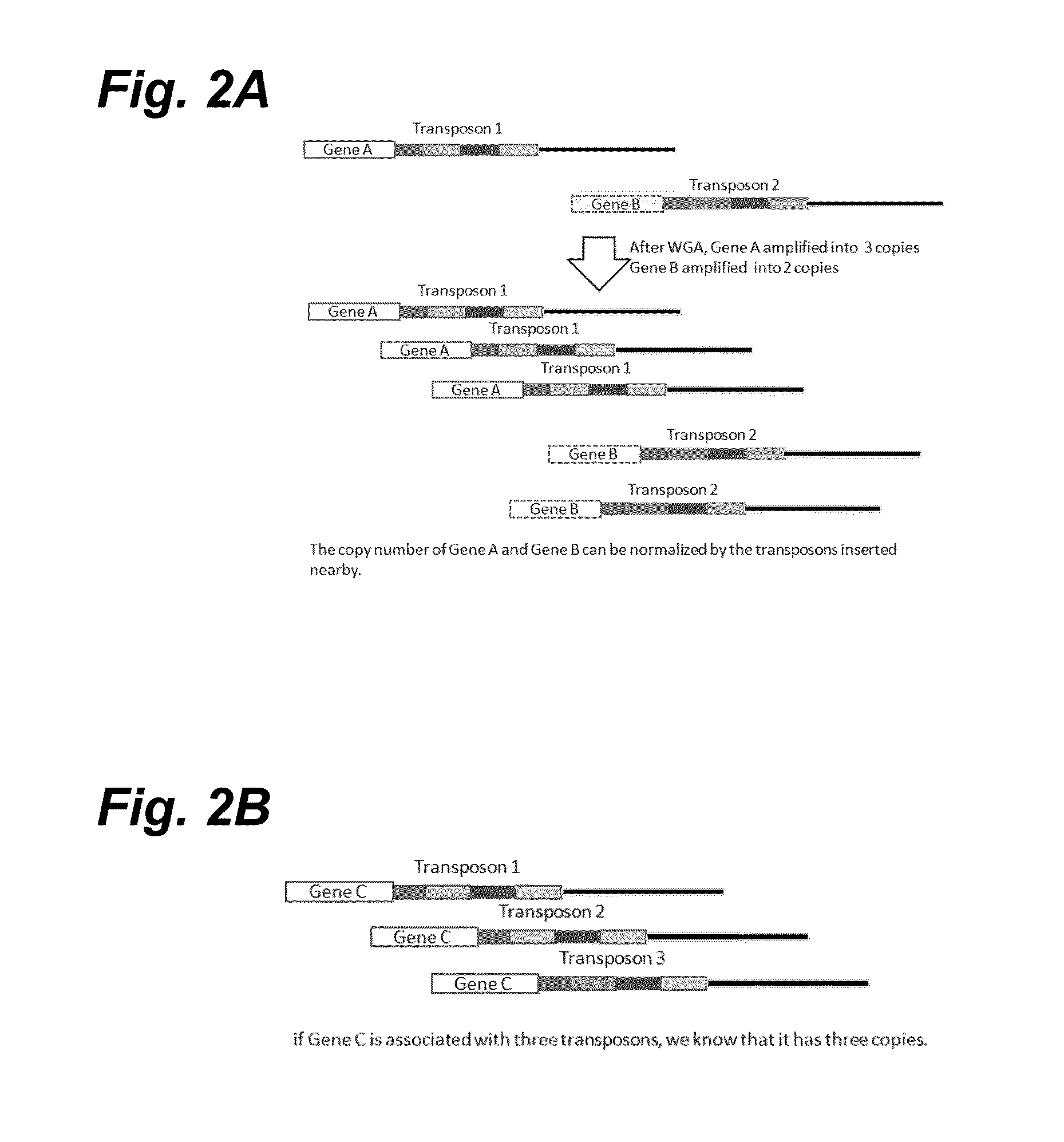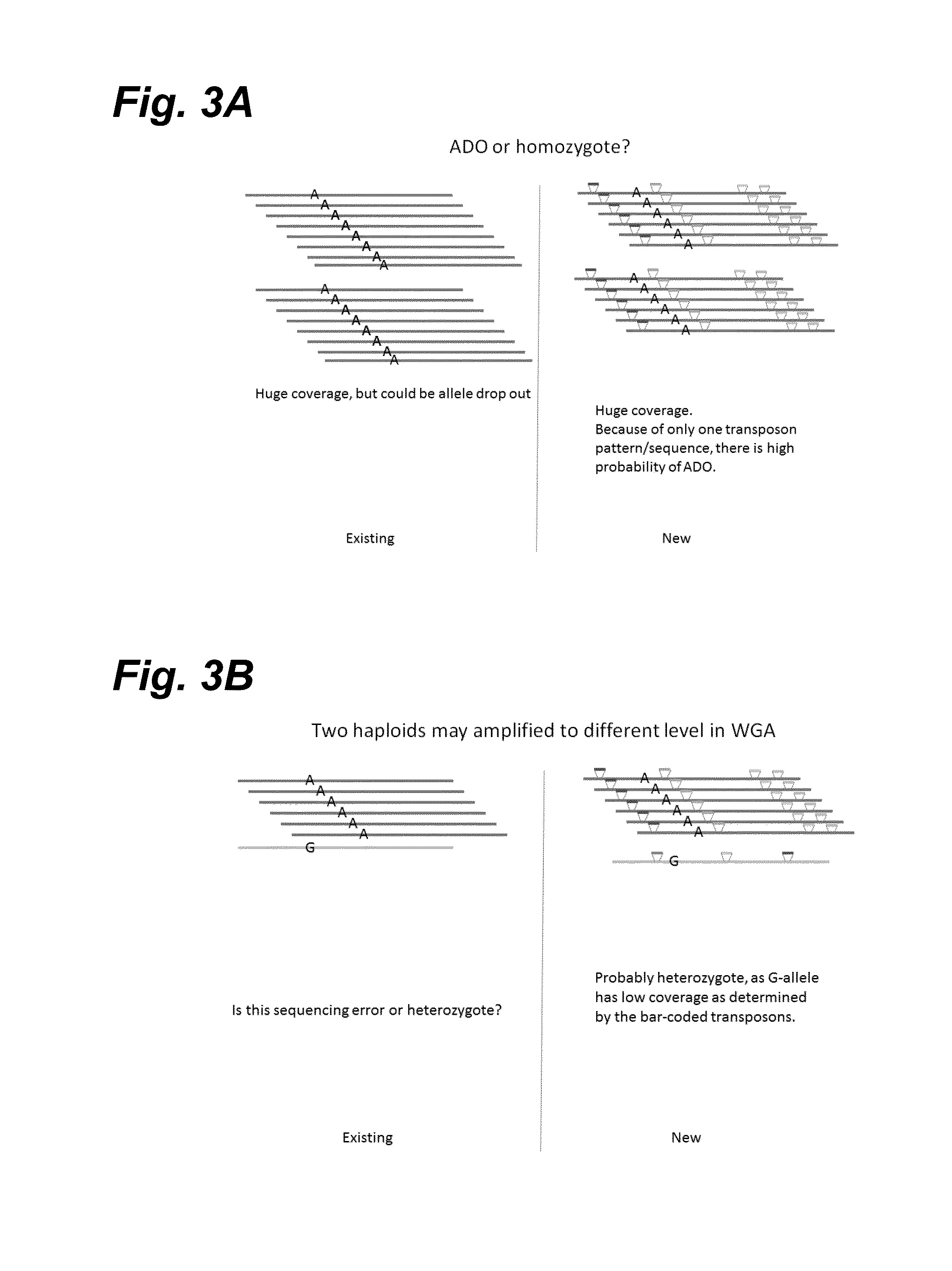Haploidome determination by digitized transposons
a technology of digitized transposons and haploidomes, applied in the field of haploidome determination using transposons, can solve the problems of difficult determination of copy number variation (cnv), over-amplification of areas, and under-amplification of areas
- Summary
- Abstract
- Description
- Claims
- Application Information
AI Technical Summary
Benefits of technology
Problems solved by technology
Method used
Image
Examples
example 1
Types of Haploidome Determinations Using Digitized Transposons
[0258]This Example describes methods to (1) accurately count absolute copy numbers of chromosomes from single cells, (2) improve accuracy in calling SNP or SNV, and (3) hyploid typing. Specifically, a set of transposons that contain a region of nucleotide sequence that serves as barcodes for the transposons is employed to “mark” DNA. For example, a group of transposons can share one common barcode, a second group of transposons can share a different, common barcode, and a third group of transposons can share a third, common barcode. Alternatively, each transposon can have its unique barcode or unique barcode combination. Although this Example is written in terms of transposons comprising barcodes, the same results can be achieved by using non-barcoded transposons that insert at unique sites that can be distinguished by sequencing.
[0259]The molecular structure of an illustrative transposon is shown in FIG. 1. At the two en...
example 2
Incorporation of Barcodes into Mu Transposon Ends
[0291]This Example illustrates the incorporation of barcodes into mu transposon ends to produce artificial transposon ends that can be used in a variety of barcoding applications. The wildtype mu transposon end has the structure as shown below, followed by a set of artificial transposon ends (top strand only) including barcodes at positions 3-5. The barcoded ends are labeled TPBC1 (“transposon barcode 1”) to TPBC10:
1 345 285′-TGAAGCGGCGCACGAAAAAACGCGAAAG-3′(SEQ ID NO: 21)3′-ACTTCGCCGCGTGCTTTTTTGCGCTTTC-5′(SEQ ID NO: 22)TPBC1:5′-TGAAACGGCGCACGAAAAAACGCGAAAG-3′(SEQ ID NO: 23)TPBC2:5′-TGTTACGGCGCACGAAAAAACGCGAAAG-3′(SEQ ID NO: 24)TPBC3:5′-TGCCACGGCGCACGAAAAAACGCGAAAG-3′(SEQ ID NO: 25)TPBC4:5′-TGGGACGGCGCACGAAAAAACGCGAAAG-3′(SEQ ID NO: 26)TPBC5:5′-TGATTCGGCGCACGAAAAAACGCGAAAG-3′(SEQ ID NO: 27)TPBC6:5′-TGACCCGGCGCACGAAAAAACGCGAAAG-3′(SEQ ID NO: 28)TPBC7:5′-TGAGGCGGCGCACGAAAAAACGCGAAAG-3′(SEQ ID NO: 29)TPBC8:5′-TGATT...
example 3
Copy Number Determination of a Gene in an Open Chromatin Region Determined by Transposon Barcodes Inserted by Tagmentation
[0295]Individual K562 cells were captured at the 4.5 nL capture site of C1 according to manufacturer's instructions (www.Fluidigm.com). The cells were stained with LIVE / DEAD® Viability / Cytotoxicity Kit for mammalian cells (Cat L3224, Life Technologies, Carlsbad, Calif., USA) to be identified as live or dead under a microscope and also to determine the number of cells (0, 1, or 2) in each capture site. The cells were then washed with 1×PBS buffer, and soaked in the buffer before 9 nL of 1.5×TD buffer (Illumina), 1.5×TDE1 (Illumina), (components from Cat FC-121-1030, Illumina, San Diego, Calif., USA), 1.5% NP40 and 1.5×C1 loading reagents (Fluidigm) was delivered and mixed in the capture chamber and Reaction Chamber #1. These lysis and tagmentation reactions were allowed to proceed at 37° C. for 30 minutes. FIG. 8B represents the transposon used in this example. Th...
PUM
 Login to View More
Login to View More Abstract
Description
Claims
Application Information
 Login to View More
Login to View More - R&D
- Intellectual Property
- Life Sciences
- Materials
- Tech Scout
- Unparalleled Data Quality
- Higher Quality Content
- 60% Fewer Hallucinations
Browse by: Latest US Patents, China's latest patents, Technical Efficacy Thesaurus, Application Domain, Technology Topic, Popular Technical Reports.
© 2025 PatSnap. All rights reserved.Legal|Privacy policy|Modern Slavery Act Transparency Statement|Sitemap|About US| Contact US: help@patsnap.com



